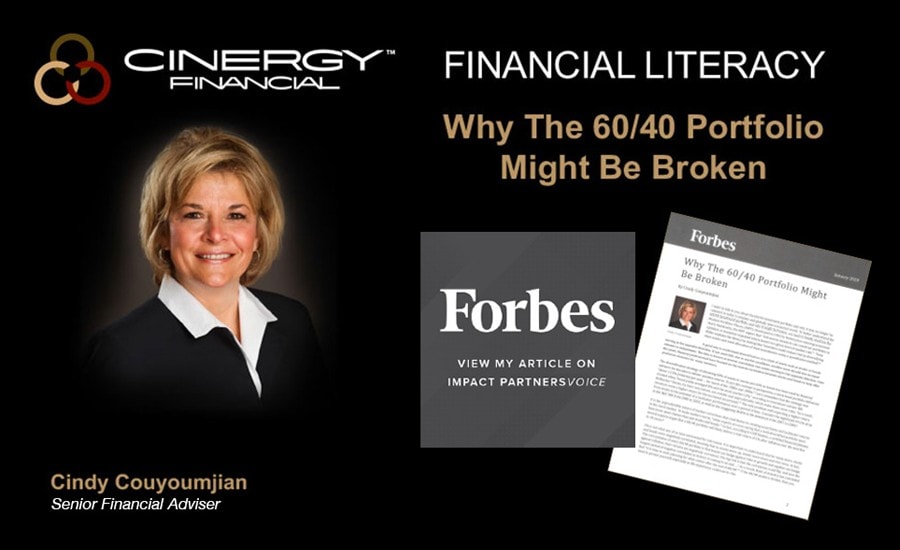Cindy Couyoumjian – Brand Contributor
Impact Partners BRANDVOICE | Jan 22, 2020
I want to talk to you about the 60/40 investment portfolio and why it may no longer be relevant in today’s complex and globally interconnected world. To better understand the 60/40 investment portfolio and why it might be broken, we need to briefly mention the Modern Portfolio Theory (MPT). Developed in 1952 by Nobel prize-winning economist Harry Markowitz, the MPT argues that “risk-averse investors can construct portfolios to optimize or maximize expected return based on a given level of market risk.” Terin Miller explains the theory by stating that “investors could reduce risk by diversifying their assets and asset allocation of their investments using a quantitative method.”
A good way to understand diversification is to think of assets such as stocks or bonds moving in the opposite direction. If one asset falls due to market conditions, another asset should rise an equal amount to compensate. The idea is known as inverse correlation: two assets moving in the opposite direction. Over the years, financial professionals have focused on the inverse correlation between stocks and bonds to help offer predictive elements for many investors.
The diversification strategy of allocating 60% of assets to stocks and 40% to bonds has been used by financial advisors for decades to deliver positive returns. To put this concept in perspective, a stock-bond portfolio delivered “about 12.5% [returns] per year … for much of the 1980s and 1990s.” Let’s remember that the strategy was created when “bond yields averaged 8% and the stock market 12%,” according to investment advisor Bill DeShurko. Stocks, by their very nature, are volatile and unpredictable, which make them more risky. “As a result, investors want a higher return for the increased uncertainty.” The only problem with expecting a higher return from stocks is the potential of a lackluster performance over a period of time. Consider the significant 49.1% drop in the S&P 500 from 2000 to 2002, as well as the staggering 56.8% in the downturn from 2007 to 2009.
It is the unpredictable nature of market corrections that contributes to creating uncertainty and lackluster returns in the stock market. To make matters worse, “some experts are now saying that a well-diversified portfolio must have more asset classes than just stocks and bonds.” In fact, according to Cliff Stanton, a certified financial planner, several experts argue that a 60/40 portfolio will likely deliver a real return of 1% after inflation over the next five to 10 years.
1% is not what any of us have envisioned for retirement. It is important to understand that for many years, stocks and bonds were negatively correlated, meaning that as stocks move up, bonds move down and vice versa. In fact, “the core premise of every 60/40 portfolio is that bonds can hedge against risks to growth and equities can hedge against inflation; their returns are negatively correlated. The big risk is that the correlation could flip, and now the longest period of negative correlation in history is coming to an end. …” As a result, Bank of America has concluded that “it is time to start planning for what comes after the end of 60/40.” If the 60/40 model is broken, then you need to protect yourself, especially as life expectancy continues to rise.
Now, you might be wondering what living longer has to do with your investment portfolio. The short answer is inflation. According to Daniel Hill, president and CEO of Hill Wealth Strategies, the 60/40 model “has potential to be problematic because as inflation rises, so will expenses.” In other words, as our expenses increase over a longer period of time, a static portfolio will not offer the necessary returns to sustain us throughout retirement.
Another problem with the 60/40 model is the 4% “withdrawal rule.” Research conducted by Wade Pfau of the Retirement Researcher suggests that you may only be able to withdraw 2.9% (adjusted annually for inflation from a 50% stock/50% bond portfolio).
It is becoming clear that a two-asset class investment model may no longer deliver the robust returns you deserve in retirement. What we need is an investment strategy that is adaptive, flexible, and customizable. I urge you to visit my website to gain a better understanding of how I developed the Retail Endowment Allocated-Like Model (REALM™) in response to the stagnant and ineffective returns of the 60/40 investment model.
View original article on Forbes.com
This content was brought to you by Impact Partners BrandVoice. Registered representative offering securities and advisory services through Independent Financial Group, LLC (IFG), a registered broker-dealer and a registered investment adviser. Member FINRA/SIPC. Cinergy Financial and IFG are unaffiliated entities. Insurance and annuities offered through Cynthia Couyoumjian, CA Insurance License #0719038
No investment process is free of risk; no strategy or risk management technique can guarantee returns or eliminate risk in any market environment. There is no guarantee that our investment processes will be profitable.
The information and opinions presented are for general information only and are not intended to provide specific advice or recommendations for any individual. You should contact your investment representative, attorney, accountant, or tax advisor with regard to your individual situation. The opinions of the presenter do not necessarily reflect those of Independent Financial Group, LLC, its affiliates, officers, or directors.
Be advised that alternative investments are speculative by nature and have various risks, including possible lack of liquidity, lack of control, changes in business conditions, and devaluation based on the investment, the economy, and/or regulatory changes. As a result, the values of alternative investments do fluctuate, resulting in the value at sale being more or less than the original price paid if a liquid market for the securities is found. DT# 1049765-0121.

